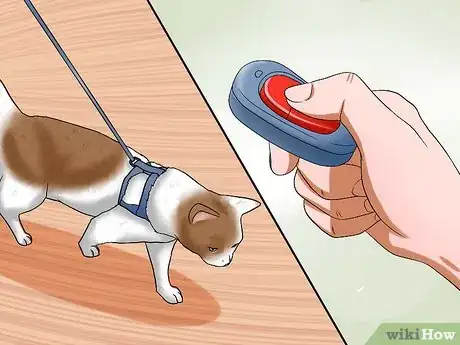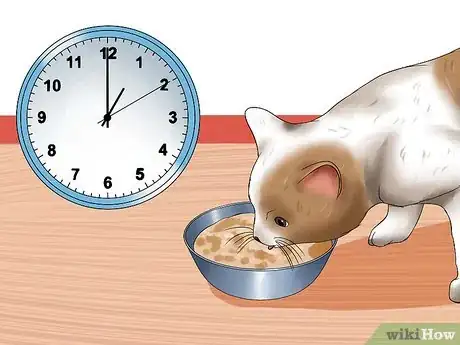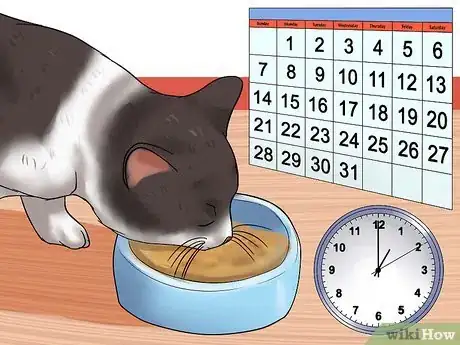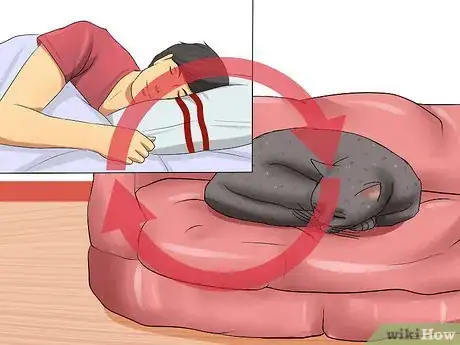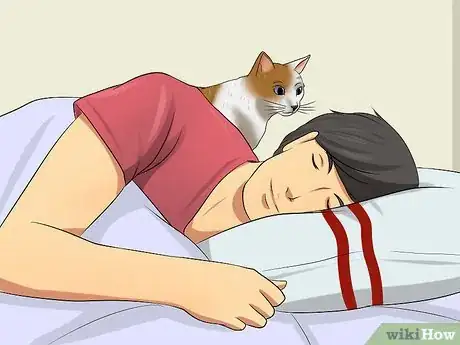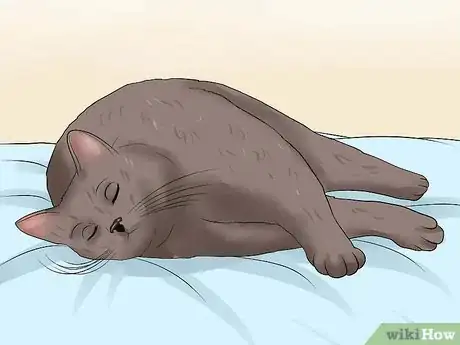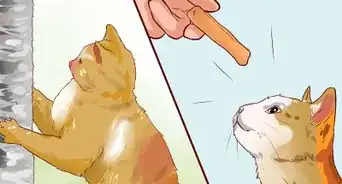This article was co-authored by Molly DeVoss. Molly DeVoss is a Certified Feline Training and Behavior Specialist (CFTBS), a Certified Cat Behavior Consultant (CCBC), a Fear Free Certified Trainer (FFCT), and the Founder of Cat Behavior Solutions. Molly specializes in using positive reinforcement to modify and prevent unwanted behaviors in cats and reduce cat shelter surrender. Molly has sat on the Dallas Animal Advisory committee since 2013 and was voted one of the Top 12 Extraordinary Cat Behaviorists of 2020 by Catpetclub.com. She is certified by both the Animal Behavior Institute and the International Association of Animal Behavior Consultants. She is also the host of the weekly podcast Cat Talk Radio.
This article has been viewed 147,371 times.
Most cats will sleep up to 16 hours a day and, contrary to popular belief, are not nocturnal. They are actually crepuscular which means they are most active at dawn and dusk. Unfortunately, if you're a pet owner, you're most likely asleep at dawn or getting ready for bed at dusk. Luckily, it's not impossible to change your cat's sleeping schedule. Since most cats thrive when a routine is established and maintained, creating a good bedtime routine can help encourage your little furry feline friend to go to sleep at the same time as you.
Steps
Playing with Your Cat
-
1Play with your cat before their last meal of the day. A cat's natural instincts are to hunt, catch, kill, and eat their prey. This is followed by grooming and then a period of rest. Recreating this scenario by playing with your cat can regulate their energy levels to meet yours. Use interactive toys like wand toys or hiding toys to hunt to tire your cat out.[1] Be sure to create a play environment that gives your cat room to run, climb, and jump.
- You should play with your cat at least 15 minutes every day and twice a day if possible.
- Try to do some "prey-playing," like using a wand toy, right before meal time. Stimulating this natural pattern will reduce stress in the cat.[2]
-
2Tire your cat out. Bored cats can be restless, exhibit inappropriate behaviours, and become aggressive. Exercise or play will help solve some unwanted behaviours, such as not allowing you to sleep at night by being aggressive, meowing throughout the night, or causing a ruckus around the house. You want to keep your cat busy and active during the day so that they don't accumulate pent up energy. There are several ways to do this:
- Play hard then rest, and play hard again. Cats are built for short spurts of energy and a good play session consists of several highs and lows. Play into this by tiring out your cat for a few minutes, letting it rest, and then restarting play again and repeat. The time it takes for your cat to tire itself out will decrease the longer you play.
- Act as prey. Playing is more than just waving a toy in your cat's face. This can be more annoying than fun for your cat. Mimic a prey's movements by moving the toy away from your cat, darting behind objects to hide, or jumping away from your cat.
- Kittens are much more active than adult cats. It may take an hour or longer to tire them out.
Advertisement -
3Enrich your cat's day with activities. Some cat owners might be working all day or don't have enough time to play with their cats. A good way to incorporate play and encourage activity throughout the day is to provide your cat with things to do and see at home without you. You can try:
- Hiding toys or treats around the house. This teaches your cat to hunt and is a good form of play when you're not around.
- Using a puzzle feeder so your cat is mentally stimulated around mealtimes.
- Turning on Cat TV. This might mean keeping your television on with the nature channel for your cat to watch. Or putting bird feeders by windows for your cat to bird-watch.
- Tossing a treat for your cat to chase.[3]
- Prey-playing with a wand toy.[4]
- Providing enrichments like climbing platforms, scratching posts, or a catio.[5]
-
4Train your cat. Another way to keep your cat busy and also encourage good behaviour is to train your cat. Cats usually repeat an action if it produces a positive consequence or a reward at the end. This is different from training an animal what not to do, which relies on giving an animal negative consequences for negative behaviours. Cats don't do well with negative consequences or punishments which can encourage more aggressive or unwanted behaviours.[6] Try:
- Clicker training. Using a small plastic device with a metal strip that makes a loud clicking noise when pressed, you can condition your cat to associate the sound with a positive reward. Every time your cat does something you want, be sure to "click" immediately upon performing the action and then give it a treat or their favourite food. There are many ways to clicker train. One way is to start clicker training by giving your cat a treat right at the moment you click. In the end, your cat will understand that a "click" means a "treat".
- Leash training. If your cat is an indoor cat, consider taking your cat outside for a walk or just to explore. This is a safer way for indoor kitties to explore the wild. Start by purchasing a harness for cats or a small harness for dogs, and a leash. Never use collared leashes as this can restrict a cat's airway or hurt their neck. Collared leashes also provide you with less control over your cat, especially if they scare easily and bolt off. Put the harness on your cat indoors first to let it get used to the feel of it. This may take a few days or weeks until your cat can walk properly with a harness on. You can train it to follow you indoors with clicker training or just follow it around with their leash on. Eventually, you can introduce it to the outside world.[7]
- With any training, it is important to be patient and to understand your cat's personality. Some cats do very well with training, some cats may take weeks to months before they can be trained, and some have personalities that don't do well with training. For example, a fearful cat would not do well with leash training and wearing a harness or going outside.
Scheduling Meals
-
1Stop free-feeding. If you are leaving food out for your cat to eat and graze on, it might be time to consider scheduling feeding times instead. When your cat has access to food whenever they want, they will be in a constant state of digestion and that can make it difficult for you to predict your cat's energy levels and have it match yours.
- Having scheduled meal times is very beneficial to your cat's health. It can manage weight and obesity issues and inform you of any health problems that may arise. A change in eating habits could go unnoticed when you're free feeding and that could mean missing symptoms of illnesses.
-
2Gradually introduce the concept of scheduled meals to your cat if you have free-fed in the past. It is important you do this process slowly and consistently. Going cold turkey could upset your cat and cause health or behavioural problems. You will notice a difference in your cat's energy and behaviour within a few weeks of serving scheduled meal times. There are several ways to transition your cat from free feeding to scheduled meal times:
- Put away food for short periods of time. You can start by putting your cat's food bowl away when you leave for work or when you're out on an errand. Then put it back down when you return. Put the food away for longer periods of time as the days go by until they match the feeding schedule that's right for you and your cat.
- Decrease the amount of free-food available every day until there is no more. At the same time, serve the remaining amount to your cat as meals.
- Feed wet food meals. Wet food tends to be eaten right away and is easier fed as a meal. As well, wet food provides moisture and has a higher protein content than some dry foods. Consult your veterinarian or pet diet specialist to find the best type of food for your cat.
- If you have a busy schedule, consider purchasing an automatic feeder. You can schedule this device to serve meals to your cat when you're not there. There are automatic feeders that serve dry food and wet food.
-
3Plan mealtimes according to your schedule. It is recommended that you feed your cat 4 times a day and schedule meals with no longer than 4-5 hours between each one.[8] The goal is to feed small measured portions of food that is eaten within 30 minutes. After each meal, your cat will typically groom itself, then rest. Try to schedule your cat's last meal so that their rest period coincides with yours. This will take some observation and a few days or weeks to establish a new feeding schedule.
- Always consult with your veterinarian and read the feeding guidelines provided by your cat's food to figure out how much and what to feed your cat. Generally, you want to feed your cat a high protein diet with little to no grains. Typically, an adult cat should eat 30 calories of food per pound while kittens will eat much more.
- Cats are designed to eat small portions throughout the day. In the wild, cats eat 10-20 small meals a day. By feeding smaller portions more frequently, you are replicating a cat's natural cycle to hunt, catch, kill, and eat its prey.[9]
- If not fed small meals frequently, your cat will grow restless due to hunger.[10]
- Feed your cat a small meal right as you head to bed—this will help them sleep through the night. Also, set a timed feeder to 3 AM, which will keep your cat calm and sleeping throughout the night.[11]
- If your cat tends to wake you up early for food, avoid feeding it right when you get up. Do it after you've showered or made your coffee to break this habit and schedule. Instead of equating breakfast with you getting up, your cat will understand that breakfast comes after other morning activities.
Going to Bed
-
1Establish a consistent bedtime routine. Cats are known for their love of routine. By having a routine that ends with you sleeping, your cat will eventually be able to understand the signs of bedtime. Be sure to do the same activities in the same order every night; brush your teeth, change your clothes, make the bed, and turn off the lights.
- Even if your cat isn't watching you, sounds of your bedtime routine will travel throughout the home.
-
2Involve your cat in your bedtime routine. Set aside certain fun activities that your cat enjoys that only happen before bedtime. You can:
- Groom your cat.
- Cuddle in bed.
- Brush your cat's teeth.
- Feed special treats.
- Lead your cat to their sleeping area.
-
3Ignore your cat when you are sleeping. The first few days or weeks may be difficult for both you and your cat, especially if you have a restless or aggressive cat. Your cat might come up to you for pets or whine at you for hours. And then you may be tempted to get up and tend to your cat. By doing this, you are giving it the attention that encourages unwanted behaviour from your cat, even if you're giving it positive attention. By ignoring your cat night after night, you are telling your cat that no matter what they do, nothing will happen. Their unwanted behaviour should eventually stop.
- Avoid getting up to get a drink of water or to use the washroom. Plan ahead as much as possible until your cat establishes the routine of going to sleep.
- Consider leaving your cat outside of the bedroom. In some cases, your cat may be too difficult to ignore while they are in the room. Do not give in and open the door for it or talk to it from inside the room.
-
4Don't get frustrated. Establishing a bedtime routine with your cat may take a few weeks and you may need to make a few sacrifices. With any behavioural training, time and patience is always the key.
- Even though you are trying to change your cat, you will also have to change. Sometimes pet training is more about compromise than about the success of learning a new behaviour. Remember, your cat is also a living thing with feelings, thoughts, preferences, and a unique personality.
-
5Finished.
Expert Q&A
-
QuestionHow can I relax my cat?
 Molly DeVossMolly DeVoss is a Certified Feline Training and Behavior Specialist (CFTBS), a Certified Cat Behavior Consultant (CCBC), a Fear Free Certified Trainer (FFCT), and the Founder of Cat Behavior Solutions. Molly specializes in using positive reinforcement to modify and prevent unwanted behaviors in cats and reduce cat shelter surrender. Molly has sat on the Dallas Animal Advisory committee since 2013 and was voted one of the Top 12 Extraordinary Cat Behaviorists of 2020 by Catpetclub.com. She is certified by both the Animal Behavior Institute and the International Association of Animal Behavior Consultants. She is also the host of the weekly podcast Cat Talk Radio.
Molly DeVossMolly DeVoss is a Certified Feline Training and Behavior Specialist (CFTBS), a Certified Cat Behavior Consultant (CCBC), a Fear Free Certified Trainer (FFCT), and the Founder of Cat Behavior Solutions. Molly specializes in using positive reinforcement to modify and prevent unwanted behaviors in cats and reduce cat shelter surrender. Molly has sat on the Dallas Animal Advisory committee since 2013 and was voted one of the Top 12 Extraordinary Cat Behaviorists of 2020 by Catpetclub.com. She is certified by both the Animal Behavior Institute and the International Association of Animal Behavior Consultants. She is also the host of the weekly podcast Cat Talk Radio.
Certified Feline Training and Behavior Specialist & Certified Cat Behavior Consultant Certified Feline Training and Behavior Specialist & Certified Cat Behavior ConsultantExpert AnswerCats feel less stressed when they follow the natural rhythm of hunt, catch, kill, eat, groom, and sleep. Help your cat follow this rhythm by playing with a wand toy right before meal time—this mimics the "hunt" aspect of this cycle.
Certified Feline Training and Behavior Specialist & Certified Cat Behavior ConsultantExpert AnswerCats feel less stressed when they follow the natural rhythm of hunt, catch, kill, eat, groom, and sleep. Help your cat follow this rhythm by playing with a wand toy right before meal time—this mimics the "hunt" aspect of this cycle. -
QuestionHow do you calm a restless cat?
 Molly DeVossMolly DeVoss is a Certified Feline Training and Behavior Specialist (CFTBS), a Certified Cat Behavior Consultant (CCBC), a Fear Free Certified Trainer (FFCT), and the Founder of Cat Behavior Solutions. Molly specializes in using positive reinforcement to modify and prevent unwanted behaviors in cats and reduce cat shelter surrender. Molly has sat on the Dallas Animal Advisory committee since 2013 and was voted one of the Top 12 Extraordinary Cat Behaviorists of 2020 by Catpetclub.com. She is certified by both the Animal Behavior Institute and the International Association of Animal Behavior Consultants. She is also the host of the weekly podcast Cat Talk Radio.
Molly DeVossMolly DeVoss is a Certified Feline Training and Behavior Specialist (CFTBS), a Certified Cat Behavior Consultant (CCBC), a Fear Free Certified Trainer (FFCT), and the Founder of Cat Behavior Solutions. Molly specializes in using positive reinforcement to modify and prevent unwanted behaviors in cats and reduce cat shelter surrender. Molly has sat on the Dallas Animal Advisory committee since 2013 and was voted one of the Top 12 Extraordinary Cat Behaviorists of 2020 by Catpetclub.com. She is certified by both the Animal Behavior Institute and the International Association of Animal Behavior Consultants. She is also the host of the weekly podcast Cat Talk Radio.
Certified Feline Training and Behavior Specialist & Certified Cat Behavior Consultant Certified Feline Training and Behavior Specialist & Certified Cat Behavior ConsultantExpert AnswerIf not fed small meals frequently, a cat will be restless due to hunger. For instance, only feeding your cat at 7 am and 7 pm is way too much of a gap. Instead, feed your cat a small meal before you head to bed, and set up a timed feeder to go off at 3 am.
Certified Feline Training and Behavior Specialist & Certified Cat Behavior ConsultantExpert AnswerIf not fed small meals frequently, a cat will be restless due to hunger. For instance, only feeding your cat at 7 am and 7 pm is way too much of a gap. Instead, feed your cat a small meal before you head to bed, and set up a timed feeder to go off at 3 am. -
QuestionHow can I get my cat to release pent-up energy?
 Molly DeVossMolly DeVoss is a Certified Feline Training and Behavior Specialist (CFTBS), a Certified Cat Behavior Consultant (CCBC), a Fear Free Certified Trainer (FFCT), and the Founder of Cat Behavior Solutions. Molly specializes in using positive reinforcement to modify and prevent unwanted behaviors in cats and reduce cat shelter surrender. Molly has sat on the Dallas Animal Advisory committee since 2013 and was voted one of the Top 12 Extraordinary Cat Behaviorists of 2020 by Catpetclub.com. She is certified by both the Animal Behavior Institute and the International Association of Animal Behavior Consultants. She is also the host of the weekly podcast Cat Talk Radio.
Molly DeVossMolly DeVoss is a Certified Feline Training and Behavior Specialist (CFTBS), a Certified Cat Behavior Consultant (CCBC), a Fear Free Certified Trainer (FFCT), and the Founder of Cat Behavior Solutions. Molly specializes in using positive reinforcement to modify and prevent unwanted behaviors in cats and reduce cat shelter surrender. Molly has sat on the Dallas Animal Advisory committee since 2013 and was voted one of the Top 12 Extraordinary Cat Behaviorists of 2020 by Catpetclub.com. She is certified by both the Animal Behavior Institute and the International Association of Animal Behavior Consultants. She is also the host of the weekly podcast Cat Talk Radio.
Certified Feline Training and Behavior Specialist & Certified Cat Behavior Consultant Certified Feline Training and Behavior Specialist & Certified Cat Behavior ConsultantExpert AnswerPlay with your cat by using a wand toy or throwing a treat for them to run after. You can also add scratching posts, climbing platforms, and/or a catio to your living space, which may help reduce your cat's stress.
Certified Feline Training and Behavior Specialist & Certified Cat Behavior ConsultantExpert AnswerPlay with your cat by using a wand toy or throwing a treat for them to run after. You can also add scratching posts, climbing platforms, and/or a catio to your living space, which may help reduce your cat's stress.
Warnings
- Always have water available for your cat.⧼thumbs_response⧽
- Panting can be normal after exercise. However, any wheezing or coughing that follows panting, can be signs that your cat has heart or respiratory problems. Take your cat to the vet immediately if they show these symptoms.⧼thumbs_response⧽
- Never use your hands as play things with your cat. You can get seriously hurt and your cat may equate you as prey or something to fear. Always play with your cat using toys.⧼thumbs_response⧽
- Cats are desert animals and get most of their water from food. Be sure that your cat is drinking water or receiving water from wet canned food. It is usually recommended you feed your cat a can of wet food if they are on a dry food diet. Or mix in water with their kibble if they don't particularly do well with wet food.⧼thumbs_response⧽
References
- ↑ Molly DeVoss. Certified Feline Training and Behavior Specialist & Certified Cat Behavior Consultant. Expert Interview. 15 July 2021.
- ↑ Molly DeVoss. Certified Feline Training and Behavior Specialist & Certified Cat Behavior Consultant. Expert Interview. 15 July 2021.
- ↑ Molly DeVoss. Certified Feline Training and Behavior Specialist & Certified Cat Behavior Consultant. Expert Interview. 15 July 2021.
- ↑ Molly DeVoss. Certified Feline Training and Behavior Specialist & Certified Cat Behavior Consultant. Expert Interview. 15 July 2021.
- ↑ Molly DeVoss. Certified Feline Training and Behavior Specialist & Certified Cat Behavior Consultant. Expert Interview. 15 July 2021.
- ↑ http://www.catster.com/cat-behavior/clicker-training-for-cats
- ↑ https://www.aspca.org/pet-care/virtual-pet-behaviorist/cat-behavior/teaching-your-cat-walk-leash
- ↑ Molly DeVoss. Certified Feline Training and Behavior Specialist & Certified Cat Behavior Consultant. Expert Interview. 15 July 2021.
- ↑ Molly DeVoss. Certified Feline Training and Behavior Specialist & Certified Cat Behavior Consultant. Expert Interview. 15 July 2021.
- ↑ Molly DeVoss. Certified Feline Training and Behavior Specialist & Certified Cat Behavior Consultant. Expert Interview. 15 July 2021.
- ↑ Molly DeVoss. Certified Feline Training and Behavior Specialist & Certified Cat Behavior Consultant. Expert Interview. 15 July 2021.
- ↑ http://www.catbehaviorassociates.com/the-squirt-bottle-controversy/
About This Article
To encourage your cat to go to sleep, try playing with it before its bedtime, which will help tire it out. Also, try to include your cat in your bedtime routine so it starts to recognize when it's time to go to sleep. For example, you can groom your cat and feed it special treats every night before bed and then lead it to its sleeping area. You can also try giving your cat lots of things to do during the day, like interactive toys and finding hidden treats, so it's more tired come nighttime. To learn how to change your cat's feeding schedule so it sleeps at night, scroll down!




